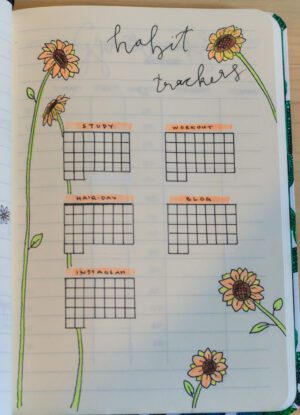
Are you tired of not reaching your new year’s resolutions? I was too. But I have collected a few good tips for how to set goals for 2022, which are helpful for anyone, but especially for students.
Wanna hear them? Keep reading!
How to Set Goals for 2022
Let’s set an example goal and look at it at each of the steps so you get an idea of how these tips apply in real life.
Let our example goal be: live a more sustainable life.

RELATED POSTS
Step 1: Review your Goals from Last Year
To make a fresh start in 2022, it is important to first look back onto 2021.
What goals did you set for last year? Did you achieve them? Why didn’t you achieve them?
In this step, we don’t even think about our new goals yet.
After you have an idea of all those things and are ready to end the past year, you can move on to your new goals.
Step 2: Think about what you REALLY want to Achieve
It won’t help you to set goals that don’t reflect who you are.
Don’t look at the goals of others. Instead, focus on what you really want to achieve this year.
Is it to finally start that online side hustle? To start running once a week?
Whatever you want to start doing, make sure it is for yourself.
Let’s take our sustainability goal. Why do you want it? Is it because you want to contribute to saving the world, you like the aesthetic, or you think it’s time to be more conscious?
Whatever it is, make sure you know why you do something.
If your goal is more along the lines of losing weight, fitness, etc, make sure you do it because you want to, and not because of other people who talk bad about you and try to influence your life.
Step 3: Dream big, but Realistic
That may sound contradictory at first, but the art is to find the balance.
Don’t be afraid of setting goals you really want to achieve. Don’t limit yourself.
But also, don’t completely go crazy with setting goals you just really cannot achieve in a year.
Example: To apply step 3 to our goal to be more sustainable, think about how extensively you want to be sustainable.
It is probably not realistic to completely switch your whole house/room/life to zero waste and quit driving and flying.
So think about how you can apply it to your own situation and make it realistic to your life, while still keeping the end goal in mind.
Step 4: Get specific
This goes hand in hand with step 3!
The number 1 mistake why people don’t achieve their goals is because they are too broad.
If your goal has lots of room of interpretation, you are less likely to follow up with it, cause you will think that it “still counts”.
Taking our sustainability goal, it is way too broad. How could we make it more specific?
A few ideas would include:
- Don’t buy plastic water bottles
- Always look for bus or train options when planning a trip
- Buy local veggies and fruit
- Quit plastic bags
These are all specific, and reachable, goals.
Here are a few more examples:
- Instead of: do more sports, say: run 2x a week
- Instead of: eat more healthy, say: eat salad 3x a week and vegan 1x a week
- Instead of: study more, say: study at least 30 minutes every day
Those are all just examples, but I think you get the idea.
Step 5: Set it up for Success
Achieving goals can be hard when you are constantly tempted!
Make it easy for yourself to reach your goals.
For example, with our goal to quit single-use plastics, you can always keep reusable bags in your car/bike/bag and get a refillable bottle that lasts you long.
That way, you aren’t constantly tempted to buy a bottle of water so you don’t die, because you always keep your own with you.
This can be applied to any goal!
- Eating healthy: don’t even bother buying unhealthy things. If you only have good things at home, that’s what you’ll eat!
- Journal every morning: get a pretty journal and set it next to your bed
and much more.
Step 6: Write it Down!
I think you can guess why this is an important component of how to set goals for 2021 and achieve them!
Based on a study, you remember 70% of what you write down, which is much more than if you just think about it once and never bring it up again.
If you DO something, you are actually remembering 90% of it, so that’s good to know too!
Anyway, writing it down helps you not only to remember it, but also manifests your goals when you read them every day, and just have them ready for reference.
Also, if you don’t write them down, how are you going to review them at the end of the year?
If you really want to reach your goal, you need to have it written down, put on the wall, visualized on a vision board, etc.
[convertkit form=1688718]Step 7: Visualize
As I just mentioned in the last step, the written part, it is also important to be reminded of the goal by seeing it in action.
Here are a few ways you can do that:
- Create a so-called “vision board”, which you can fill with pictures and articles of your goal.
- Write it in pretty fonts and frame it, hang it on your wall, door, etc
- Write it on sticky notes and place it on several things in your room or house.
- Photoshop yourself into it. Example: Your goal is to save 10k to buy a car. If you can’t test drive it and take a picture, google for an image of your dream car and (if you can) photoshop yourself into the car. Then, hang it on your wall so you are visually reminded to save that money!
Step 8: Break your Goal into Small Chunks
To tackle your goal and really reach it, it is important to break it down into smaller parts or maybe even monthly goals.
That way, it isn’t as intimidating to start working on it.
Taking our sustainability goal once again. Let’s say that the overall goal is to switch from using wasteful and toxic things to using compostable and sustainable items.
To break that down into monthly goals, for example, I would write it down as follows:
- Month 1: Buy a reusable bottle, don’t buy single-use bottles, set own bags ready into car/bag/etc, don’t use bags from the grocery store unless it is paper
- Month 2: Use up shower products (if it’s not finished the same month, just move it to the next one until you’re ready)
- Month 3: Switch to solid shower products, try out what works for you
- Month 4: Tackle cleaning supplies. Try out recipes instead of toxic products that are killing ecosystems
and so on!
That is just an example of how I would break down a big goal into small steps. You can do this with literally any goal you have!
Step 9: Track your Goal
The only way you’re gonna reach your goal (unless magic happens or you win the lottery) is if you stay on track and know where you are at.
This isn’t necessary for every goal, but if it’s about changing or improving habits, it is very helpful to track them.
I usually track my habits in my bullet journal, but you can do it on a piece of paper, a printable from the web, etc.
Here is an example of how my trackers look like for 1 month:

RELATED: 10 Bullet Journal Spreads for Students
So for our example goal, you could track:
- when you didn’t use single-use plastic
- when you donated money
- when you didn’t use your car
- when you switched to something more eco-friendly
- etc.
If your goal is to eat more healthy, you can track your days with no candy.
If your goal is to run 2x a week, track what days you actually went for a run.
Step 10: Be Persistent
Almost done with this how to set goals for 2020 post! This next step is to be persistent.
Stay focused, and you will make it!
It is totally okay to maybe change your goal up if something happened in your life that changed your mind (example: maybe you broke your leg which makes it impossible for you to reach your goal of running 2x a week).
But if you want to achieve a goal, be persistent with doing it and making it happen.
Step 11: Reflect
Last but certainly not least, we have: reflection.
Just like in the first step, reviewing your past goals and figuring out how you did in achieving them, it is important to look back onto these new goals and reflect on them.
You can reflect on your progress throughout the year too, but I like to do it at the end of the year as well.
I look at the initial goal and the monthly goals and check off what I achieved. I also write down the achievement, since it sometimes differs from the initial goal.
Lastly, don’t forget to treat yourself for reaching a goal!
(of course not with something that throws you back with your goal), but something you enjoy doing.
In Conclusion
These were my 10 Steps to How to Set Goals for 2022!
We talked about reflecting on previous goals, how to set realistic goals, break them down into small steps, and how to track them, just to name a few.
I hope you enjoyed this post and it helped you figure out how to set goals for 2022 and really achieve them!
What are your goals for this next year? Comment below, I need some more ideas!
Until soon,







Leave a Reply